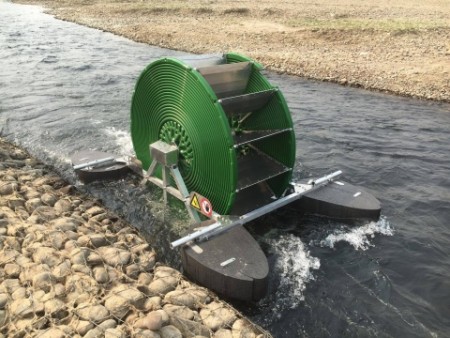May 27, 2016 -Water wheels have been around for more than 2,500 years. The Greeks are credited with the invention although the water wheel shows up in ancient China as well. Another Greek invention the Archimedes screw pump transferred water from low-lying bodies of water to irrigate fields away from the water source.
These two low-technology water moving inventions have been combined into a device called the Barsha Pump. “Barsha” is a Bengali word that means “rain.” And what this modern version of the ancient water wheel combined with an Archimedes screw-like internal mechanism is all about is moving water uphill to where it is needed. The mechanism is pretty simple. It derives its power from the kinetic energy of water flow. This rotates what appears to be a traditional water wheel. But the insides contain a spiral pumping mechanism that looks a lot like an Archimedes screw. But instead of the screw moving water it draws air from the outside and as the water wheel spins compresses and decompresses it. The air pushes the water out a valve mounted on the side of the wheel. With an attached hose the water can then be transported to where it is needed. You can even attach a sprinkler head because power is sufficient to drive it. All this happens without any need for fossil fuels or an electrical power source. That means no carbon emissions.
The Barsha Pump is the invention of a team of three engineers from Delft University of Technology in The Netherlands. Delft University is the inspiration for a wide number of inventions and has become home to the largest high-tech incubator in Europe a company named aQysta. The three co-founders, Lennart Budelmann, Fred Henny and Pratap Thapa, have described their mission to find technological solutions that address world challenges in an environmentally sustainable manner.
If you go to the aQysta website there is a description about how to get a Barsha Pump for your community. Lead requirement is a steady flow of water either from a river or canal. Second is the filling in of a site feasibility form. aQysta reviews the form and if a site is deemed suitable ships a pump with installation instructions. The Pump can be set up and operating within a day, which means access to precious freshwater continuously with no negative environmental impact.
Described as a low-cost irrigation solution for small and medium-sized farms, the inventors claim over the 5 to 10 year lifetime it will save 70% in operating costs alone. The global market is estimated to be worth several billion dollars and growing. However, I have yet to find out the unit price and have written to the inventors to get a quote. I’ll let you know when I hear back.









